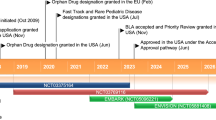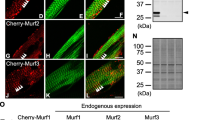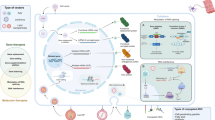Abstract
The genetically determined muscular dystrophies are caused by mutations in genes coding for muscle proteins. Differences in the phenotypes are mainly the age of onset and velocity of progression. Muscle weakness is the consequence of myofiber degeneration due to an imbalance between successive cycles of degeneration/regeneration. While muscle fibers are lost, a replacement of the degraded muscle fibers by adipose and connective tissues occurs. Major investigation points are to elicit the involved pathophysiological mechanisms to elucidate how each mutation can lead to a specific degenerative process and how the regeneration is stimulated in each case. To answer these questions, we used four mouse models with different mutations causing muscular dystrophies, Dmd mdx, SJL/J, Large myd and Lama2 dy2J /J, and compared the histological changes of regeneration and fibrosis to the expression of genes involved in those processes. For regeneration, the MyoD, Myf5 and myogenin genes related to the proliferation and differentiation of satellite cells were studied, while for degeneration, the TGF-β1 and Pro-collagen 1α2 genes, involved in the fibrotic cascade, were analyzed. The result suggests that TGF-β1 gene is activated in the dystrophic process in all the stages of degeneration, while the activation of the expression of the pro-collagen gene possibly occurs in mildest stages of this process. We also observed that each pathophysiological mechanism acted differently in the activation of regeneration, with distinctions in the induction of proliferation of satellite cells, but with no alterations in stimulation to differentiation. Dysfunction of satellite cells can, therefore, be an important additional mechanism of pathogenesis in the dystrophic muscle.




Similar content being viewed by others
Abbreviations
- α- and β-DG:
-
Alpha and beta dystroglycan
- α, β-, γ-, δ- and ε-SG:
-
Alpha, beta, gamma, delta and epsilon sarcoglycans
- CMD:
-
Congenital muscular dystrophy
- DGC:
-
Dystroglycan complex
- DMD:
-
Duchenne muscular dystrophy
- FKRP:
-
Fukutin-related protein
- GAPDH:
-
Glyceraldehyde-3-phosphate dehydrogenase
- LGMD:
-
Limb-girdle muscular dystrophy
- MRF:
-
Muscle regulatory factor
- NMD:
-
Neuromuscular disorders
- PCOL:
-
Pro-collagen 1α2
- TGF:
-
Transforming growth factor
- TGF-β1:
-
Transforming growth factor beta 1
References
a/a-Largemyd/J, B. C. F. “http://jaxmice.jax.org/strain/000226.html”.
Anderson, J. L., Head, S. I., et al. (2005). Synaptic plasticity in the dy2J mouse model of laminin alpha2-deficient congenital muscular dystrophy. Brain Research, 1042(1), 23–28.
B6.WK-Lama2dy-2J/J “http://jaxmice.jax.org/strain/000524.html”.
Bittner, R. E., Anderson, L. V., et al. (1999). Dysferlin deletion in SJL mice (SJL-Dysf) defines a natural model for limb girdle muscular dystrophy 2B. Nature Genetics, 23(2), 141–142.
Brand-Saberi, B., & Christ, B. (1999). Genetic and epigenetic control of muscle development in vertebrates. Cell and Tissue Research, 296(1), 199–212.
Browning, C. A., Grewal, P. K., et al. (2005). A rapid PCR method for genotyping the Large(myd) mouse, a model of glycosylation-deficient congenital muscular dystrophy. Neuromuscular Disorders, 15(5), 331–335.
Bulfield, G., Siller, W. G., et al. (1984). X chromosome-linked muscular dystrophy (mdx) in the mouse. Proceedings of the National Academy of Sciences of the USA, 81(4), 1189–1192.
C57BL/10ScSn-Dmdmdx/J. “http://jaxmice.jax.org/strain/001801.html.” Retrieved August-13th-2010.
Charge, S. B., & Rudnicki, M. A. (2004). Cellular and molecular regulation of muscle regeneration. Physiological Reviews, 84(1), 209–238.
Chen, J. C., & Goldhamer, D. J. (2003). Skeletal muscle stem cells. Reproductive Biology and Endocrinology, 1, 101.
Cohn, R. D., Henry, M. D., et al. (2002). Disruption of DAG1 in differentiated skeletal muscle reveals a role for dystroglycan in muscle regeneration. Cell, 110(5), 639–648.
Cohn, R. D., van Erp, C., et al. (2007). Angiotensin II type 1 receptor blockade attenuates TGF-beta-induced failure of muscle regeneration in multiple myopathic states. Nature Medicine, 13(2), 204–210.
DiMario, J. X., Uzman, A., et al. (1991). Fiber regeneration is not persistent in dystrophic (MDX) mouse skeletal muscle. Developmental Biology, 148(1), 314–321.
Dubowitz, V., Sewry, C. A., et al. (2007). Muscle biopsy : A practical approach. Philadelphia: Saunders Elsevier.
Ervasti, J. M., & Campbell, K. P. (1993). A role for the dystrophin-glycoprotein complex as a transmembrane linker between laminin and actin. Journal of Cell Biology, 122(4), 809–823.
Ghedini, P. C., Viel, T. A., et al. (2008). Increased expression of acetylcholine receptors in the diaphragm muscle of MDX mice. Muscle and Nerve, 38(6), 1585–1594.
Goetsch, S. C., Hawke, T. J., et al. (2003). Transcriptional profiling and regulation of the extracellular matrix during muscle regeneration. Physiological Genomics, 14(3), 261–271.
Gosselin, L. E., Williams, J. E., et al. (2004). Localization and early time course of TGF-beta 1 mRNA expression in dystrophic muscle. Muscle and Nerve, 30(5), 645–653.
Gouveia, T. L., Kossugue, P. M., et al. (2007). A new evidence for the maintenance of the sarcoglycan complex in muscle sarcolemma in spite of the primary absence of delta-SG protein. Journal of Molecular Medicine, 85(4), 415–420.
Grewal, P. K., & Hewitt, J. E. (2002). Mutation of Large, which encodes a putative glycosyltransferase, in an animal model of muscular dystrophy. Biochimica et Biophysica Acta, 1573(3), 216–224.
Guglieri, M., Straub, V., et al. (2008). Limb-girdle muscular dystrophies. Current Opinion in Neurology, 21(5), 576–584.
Hawke, T. J., & Garry, D. J. (2001). Myogenic satellite cells: Physiology to molecular biology. Journal of Applied Physiology, 91(2), 534–551.
Hoffman, E. P., Brown, R. H., Jr, et al. (1987). Dystrophin: The protein product of the Duchenne muscular dystrophy locus. Cell, 51(6), 919–928.
Ignotz, R. A., & Massague, J. (1986). Transforming growth factor-beta stimulates the expression of fibronectin and collagen and their incorporation into the extracellular matrix. Journal of Biological Chemistry, 261(9), 4337–4345.
Li, Y., Foster, W., et al. (2004). Transforming growth factor-beta1 induces the differentiation of myogenic cells into fibrotic cells in injured skeletal muscle: A key event in muscle fibrogenesis. American Journal of Pathology, 164(3), 1007–1019.
Li, X., McFarland, D. C., et al. (2008a). Effect of Smad3-mediated transforming growth factor-beta1 signaling on satellite cell proliferation and differentiation in chickens. Poultry Science, 87(9), 1823–1833.
Li, X., McFarland, D. C., et al. (2008b). Extracellular matrix proteoglycan decorin-mediated myogenic satellite cell responsiveness to transforming growth factor-beta1 during cell proliferation and differentiation Decorin and transforming growth factor-beta1 in satellite cells. Domestic Animal Endocrinology, 35(3), 263–273.
Longman, C., Brockington, M., et al. (2003). Mutations in the human LARGE gene cause MDC1D, a novel form of congenital muscular dystrophy with severe mental retardation and abnormal glycosylation of alpha-dystroglycan. Human Molecular Genetics, 12(21), 2853–2861.
Meier, H., & Southard, J. L. (1970). Muscular dystrophy in the mouse caused by an allele at the dy-locus. Life Science, 9(3), 137–144.
Muntoni, F., Brockington, M., et al. (2004). Defective glycosylation in congenital muscular dystrophies. Current Opinion in Neurology, 17(2), 205–209.
Primerbank. “http://pga.mgh.harvard.edu/primerbank/index.html”. Retrieved August-13th-2010.
Schultz, E., & Lipton, B. H. (1982). Skeletal muscle satellite cells: Changes in proliferation potential as a function of age. Mechanisms of Ageing and Development, 20(4), 377–383.
Straub, V., & Campbell, K. P. (1997). Muscular dystrophies and the dystrophin-glycoprotein complex. Current Opinion in Neurology, 10(2), 168–175.
Tome, F. M., Evangelista, T., et al. (1994). Congenital muscular dystrophy with merosin deficiency. C R Academic Science III, 317(4), 351–357.
Vainzof, M., Anderson, L. V., et al. (2001). Dysferlin protein analysis in limb-girdle muscular dystrophies. Journal of Molecular Neuroscience, 17(1), 71–80.
Vainzof, M., Ayub-Guerrieri, D., Onofre, P. C., Martins, P. C., Lopes, V. F., Zilberztajn, D., et al. (2008). Animal models for genetic neuromuscular diseases. Journal of Molecular Neuroscience, 34(3), 241–248.
Wagers, A. J., & Conboy, I. M. (2005). Cellular and molecular signatures of muscle regeneration: Current concepts and controversies in adult myogenesis. Cell, 122(5), 659–667.
Weller, A. H., Magliato, S. A., et al. (1997). Spontaneous myopathy in the SJL/J mouse: Pathology and strength loss. Muscle and Nerve, 20(1), 72–82.
Yablonka-Reuveni, Z., Day, K., et al. (2008). Defining the transcriptional signature of skeletal muscle stem cells. Journal of Animal Science, 86(14 Suppl), E207–E216.
Yoshida, M., & Ozawa, E. (1990). Glycoprotein complex anchoring dystrophin to sarcolemma. Journal of Biochemistry, 108(5), 748–752.
Acknowledgments
The authors would like to thank the following researchers for scientific and technical support: Dra. Mayana Zatz, Dra. Helga C. Silva, Lydia Yamamoto and Marta Canovas. We would also like to thank Dr. Paulo Otto for the statistical analyses, Dr. Peter Pearson for the English revision, and Ms. Claudia Mori and IPEN for taking care of the mice. This work was supported by Fundação de Amparo a Pesquisa do Estado de São Paulo—Centro de Pesquisa, Inovação e Difusão (FAPESP-CEPID), Conselho Nacional de Desenvolvimento Científico e Tecnológico (CNPq), Instituto Nacional de Ciência e Tecnologia (INCT), FINEP, and Associação Brasileira de Distrofia Muscular (ABDIM).
Author information
Authors and Affiliations
Corresponding author
Rights and permissions
About this article
Cite this article
Onofre-Oliveira, P.C.G., Santos, A.L.F., Martins, P.M. et al. Differential Expression of Genes Involved in the Degeneration and Regeneration Pathways in Mouse Models for Muscular Dystrophies. Neuromol Med 14, 74–83 (2012). https://doi.org/10.1007/s12017-012-8172-3
Received:
Accepted:
Published:
Issue Date:
DOI: https://doi.org/10.1007/s12017-012-8172-3




